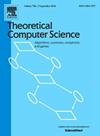Existence and construction of a C-shaped module within a floorplan
IF 0.9
4区 计算机科学
Q3 COMPUTER SCIENCE, THEORY & METHODS
引用次数: 0
Abstract
For a given graph, this paper presents a graph-theoretic approach for creating a floorplan with a specific module, i.e., a C-shaped module. Unlike traditional methods that only consider boundary layouts for floorplan generation, this research considers constraints related to constructing the desired modules. The central objective is to explore how graph theoretic properties can ensure the integration of C-shaped modules within floorplans that have rectangular boundaries.
A key innovation lies in introducing the concept of non-triviality for these modules, which becomes crucial for achieving the desired non-trivial C-shaped module (a non-trivial module means that it cannot be transformed into other shaped modules by stretching or shrinking its module walls, i.e. if its module walls are stretched or shrinked, then either the bends of its neighboring modules may increase or the given adjacency may not be preserved).
The proposed solution involves a linear-time algorithm based on the concept of canonical labeling. The algorithm introduces prioritized canonical labeling to generate a non-trivial C-shaped module within the floorplan. It operates on a given plane triangulated graph (PTG) that contains at least one interior . The paper outlines the algorithm and establishes the essential conditions for constructing a non-trivial C-shaped module within the floorplan of a given plane triangulated graph (PTG) G. Notably, the algorithm's simplicity and ease of implementation set it apart. In future work, we will focus on generating the existence and construction of other desired shaped modules for the given input graphs.
求助全文
约1分钟内获得全文
求助全文
来源期刊

Theoretical Computer Science
工程技术-计算机:理论方法
CiteScore
2.60
自引率
18.20%
发文量
471
审稿时长
12.6 months
期刊介绍:
Theoretical Computer Science is mathematical and abstract in spirit, but it derives its motivation from practical and everyday computation. Its aim is to understand the nature of computation and, as a consequence of this understanding, provide more efficient methodologies. All papers introducing or studying mathematical, logic and formal concepts and methods are welcome, provided that their motivation is clearly drawn from the field of computing.
 求助内容:
求助内容: 应助结果提醒方式:
应助结果提醒方式:


